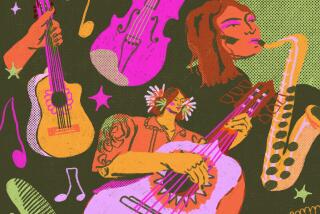AROUND HOME : Instruments
- Share via
THERE ARE TWO very different kinds of collectors who are drawn to antique musical instruments: One is a musician who prizes the playing qualities of old instruments (and even uses them for performances); the other is a collector fascinated by historical and decorative considerations.
From a performance point of view, 17th-Century violins are almost a necessity for certain major concerts, and many early-20th-Century guitars are considered superior to most made today. Sound, however, is only one of the elements. Collectors look for historical associations, attractive shapes, interesting decorations, valuable materials and technological innovations. Music has played an important role in civilization, and instruments have always been cherished and beautifully decorated.
Instruments can be grouped in four basic categories: stringed, wind, brass and percussion. The most desired stringed instruments are, of course, violins. Fine, old specimens--those instruments made by the Amati and Guarneri families and by Antonio Stradivari from the 16th Century to the 18th Century--generally are owned by museums or reserved for concert use. Some charming variations are more available: dancing masters’ fiddles, for example, the pochette or the kit , designed to be carried in the pocket.
Unusual instruments and unusual materials have been found in every era and in every country. Flutes, in particular, have been made in a variety of substances: boxwood, ebony, silver, gold, platinum, glass. Examples of striking and unusual instruments: a 22-inch-long traveling piano (with mirror and sewing box), made in Vienna about 1800; a portable reed organ, called a Bible harmonium because of its shape; a grand harmonicon (a collection of musical glasses). There is a bewildering variety available: all manner of clarinets, snare drums, dulcimers, mandolins, cornets, electric guitars; every kind of spinet, clavichord, fortepiano, harpsichord, virginal; all shapes and sizes of barrel organs, banjos (developed from instruments brought to the New World by African slaves), hurdy-gurdies (stringed instruments, not barrel organs), dulcimers, harps, zithers. The list seems without end; for collectors some specialization is necessary.
There are also beautiful Chinese and Japanese instruments, lutes and banjos of many shapes and sizes and tones, Indian sitars, African drums and stringed instruments, Russian balalaikas, bagpipes (which come from not only Scotland but Italy as well).
Collectibles extend to memorabilia about musicians from every part of the world: autographs, portraits, manuscripts and scores.
Old musical instruments can be found in many places; swap meets and pawn shops should not be overlooked. Also try Musicians’ Supply Shop in West Los Angeles; McCabe’s Guitar Shop in Santa Monica; Harpsichord Center (reproductions) in Eagle Rock; Folk Music Center (a fascinating museum with many instruments for sale) in Claremont; Shade Tree Stringed Instruments in Laguna Niguel; Vallejo Gallery in Newport Beach, and A. B. Music Exchange in San Diego.


